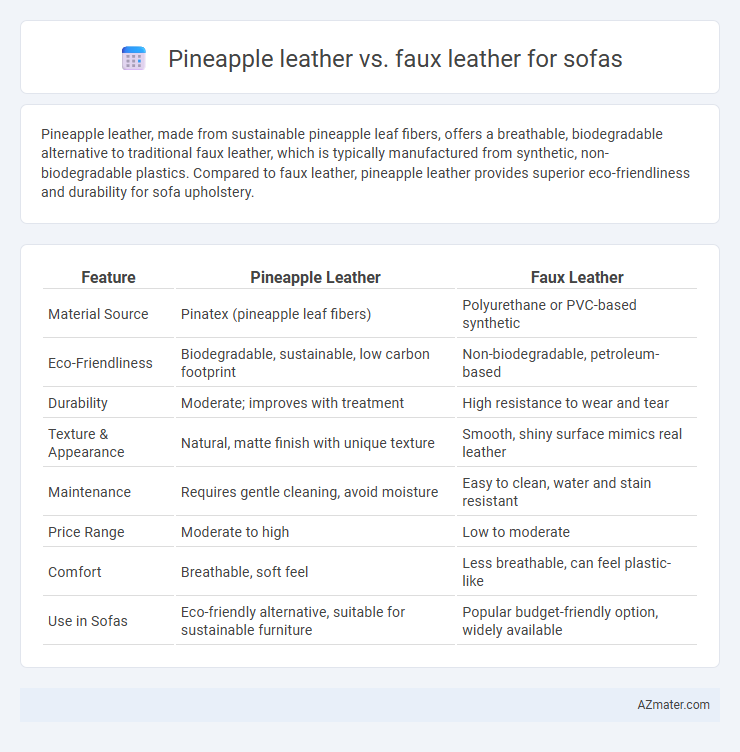Pineapple leather, made from sustainable pineapple leaf fibers, offers a breathable, biodegradable alternative to traditional faux leather, which is typically manufactured from synthetic, non-biodegradable plastics. Compared to faux leather, pineapple leather provides superior eco-friendliness and durability for sofa upholstery.
Table of Comparison
| Feature | Pineapple Leather | Faux Leather |
|---|---|---|
| Material Source | Pinatex (pineapple leaf fibers) | Polyurethane or PVC-based synthetic |
| Eco-Friendliness | Biodegradable, sustainable, low carbon footprint | Non-biodegradable, petroleum-based |
| Durability | Moderate; improves with treatment | High resistance to wear and tear |
| Texture & Appearance | Natural, matte finish with unique texture | Smooth, shiny surface mimics real leather |
| Maintenance | Requires gentle cleaning, avoid moisture | Easy to clean, water and stain resistant |
| Price Range | Moderate to high | Low to moderate |
| Comfort | Breathable, soft feel | Less breathable, can feel plastic-like |
| Use in Sofas | Eco-friendly alternative, suitable for sustainable furniture | Popular budget-friendly option, widely available |
Introduction to Sustainable Sofa Materials
Pineapple leather, made from the fibrous leaves of the pineapple plant, offers a biodegradable and eco-friendly alternative to traditional faux leather used in sofas. Unlike faux leather, which is typically produced from polyurethane or polyvinyl chloride (PVC) and involves significant plastic use, pineapple leather reduces environmental impact through renewable resources and lower chemical processing. Sustainable sofa materials like pineapple leather contribute to healthier indoor air quality and support circular economy initiatives in furniture manufacturing.
What is Pineapple Leather?
Pineapple leather, also known as Pinatex, is an innovative sustainable material made from the cellulose fibers extracted from pineapple leaves, offering an eco-friendly alternative to traditional faux leather. This plant-based leather provides durability, breathability, and a unique textured appearance while reducing environmental impact compared to synthetic polyurethane or PVC-based faux leather. Pineapple leather's natural origin and biodegradable properties make it a preferred choice for eco-conscious consumers seeking stylish, animal-free sofa upholstery.
Understanding Faux Leather
Faux leather, also known as synthetic leather, is made from plastic-based materials like polyurethane (PU) or polyvinyl chloride (PVC), designed to mimic the appearance and texture of genuine leather. It offers durability, water resistance, and easy maintenance, making it a popular choice for sofas in high-traffic areas or homes with pets and children. Compared to pineapple leather, a plant-based alternative derived from pineapple leaves, faux leather typically costs less but lacks the environmental benefits associated with sustainable and biodegradable materials.
Environmental Impact: Pineapple vs Faux Leather
Pineapple leather, derived from the natural fibers of pineapple leaves, offers a biodegradable and sustainable alternative to traditional faux leather, which is primarily made from non-renewable petroleum-based plastics. The production of pineapple leather generates significantly lower carbon emissions and reduces reliance on harmful chemicals compared to synthetic faux leather manufacturing. Choosing pineapple leather for sofas helps minimize environmental pollution and promotes waste reduction by utilizing agricultural byproducts.
Durability and Lifespan Comparison
Pineapple leather, made from sustainable pineapple leaf fibers, offers a unique combination of eco-friendliness and durability, typically lasting around 5 to 7 years with proper care. Faux leather, often crafted from polyurethane or PVC, can be more resistant to scratches and stains but tends to degrade faster, usually lasting 3 to 5 years before peeling or cracking occurs. When choosing between the two for sofas, pineapple leather provides a longer lifespan with natural breathability and aging characteristics, while faux leather offers initial durability but may require more frequent replacement.
Comfort and Aesthetic Appeal
Pineapple leather offers superior breathability and softness compared to traditional faux leather, enhancing comfort for prolonged seating. Its natural texture and unique grain patterns create an aesthetically pleasing and eco-friendly alternative to synthetic materials. Faux leather, while durable and easy to maintain, often lacks the organic feel and distinctive appearance that pineapple leather provides.
Maintenance and Cleaning Requirements
Pineapple leather, derived from pineapple leaf fibers, offers a biodegradable and breathable alternative that resists stains and requires only mild soap and water for easy cleaning, making maintenance straightforward and eco-friendly. Faux leather, typically made from PVC or PU, demands regular conditioning to prevent cracking and may be more susceptible to wear from harsh cleaners or heat exposure. Both materials benefit from gentle cleaning routines, but pineapple leather's natural properties reduce the buildup of dirt and odors over time, enhancing sofa longevity with less intensive upkeep.
Cost Analysis: Pineapple Leather vs Faux Leather Sofas
Pineapple leather sofas generally have higher upfront costs compared to faux leather due to sustainable production methods and limited availability of pinatex material. Faux leather remains more affordable with mass production and synthetic materials, making it a budget-friendly option for many consumers. When considering long-term value, pineapple leather offers durability and eco-friendliness that can justify the initial investment over faux leather alternatives.
Consumer Preferences and Market Trends
Pineapple leather, derived from sustainable Pinatex fibers, appeals to eco-conscious consumers seeking cruelty-free and biodegradable alternatives to traditional faux leather made from synthetic PVC or PU materials. Market trends indicate a growing demand for pineapple leather sofas due to their natural texture, breathability, and lower environmental impact compared to conventional faux leather's reliance on petrochemicals and limited durability. Consumer preferences increasingly favor innovative, plant-based upholstery options, driving brands to incorporate pineapple leather into premium and mid-range sofa collections for a niche yet expanding market segment.
Conclusion: Which Sofa Material is Better?
Pineapple leather offers eco-friendly benefits with its sustainable, biodegradable material derived from pineapple leaf fibers, making it a strong contender against traditional faux leather. Faux leather, typically made from PVC or polyurethane, provides greater durability and easier maintenance but involves synthetic, less environmentally friendly production processes. For sofa materials, pineapple leather is better suited for eco-conscious consumers valuing sustainability, while faux leather excels in affordability and long-lasting wear.

Infographic: Pineapple leather vs Faux leather for Sofa
 azmater.com
azmater.com